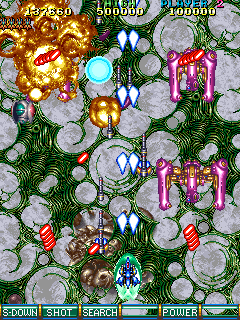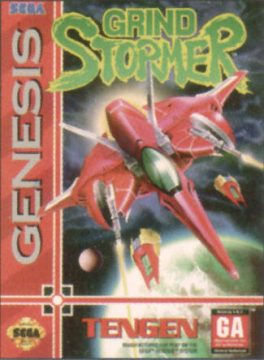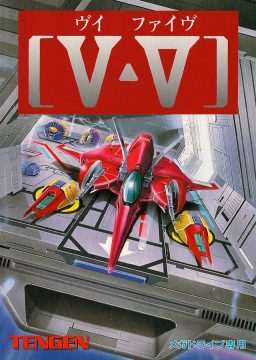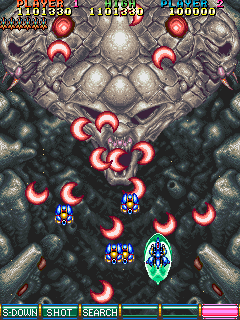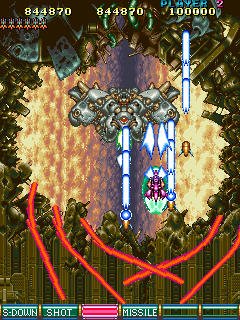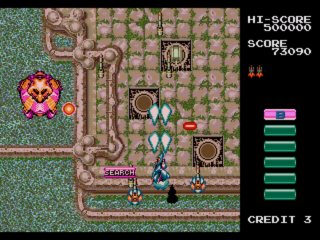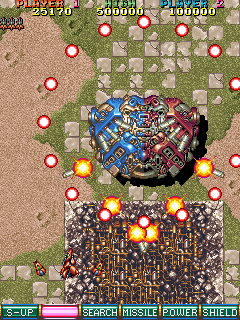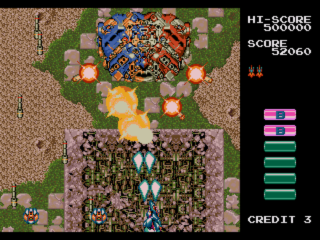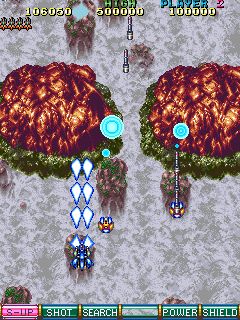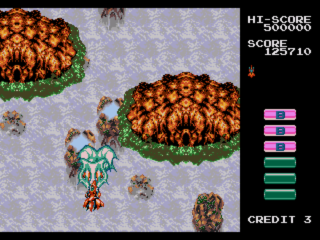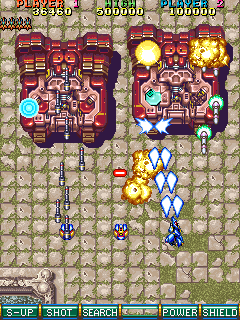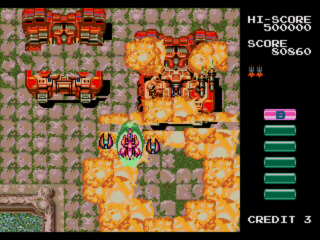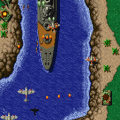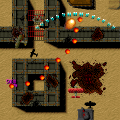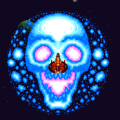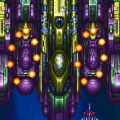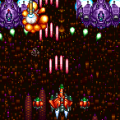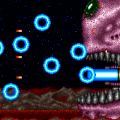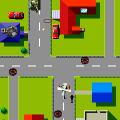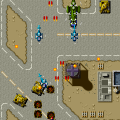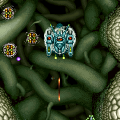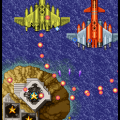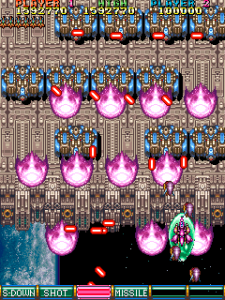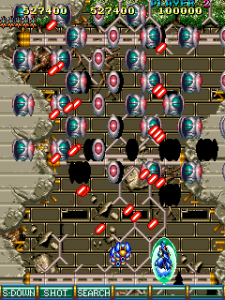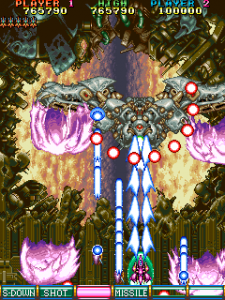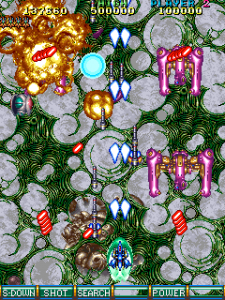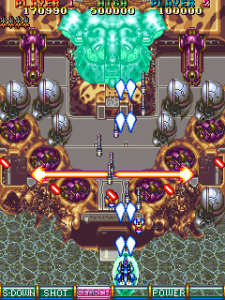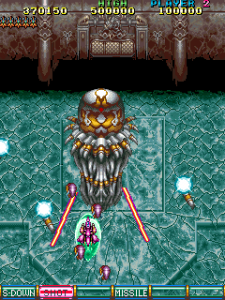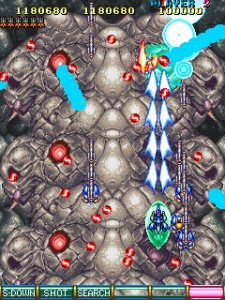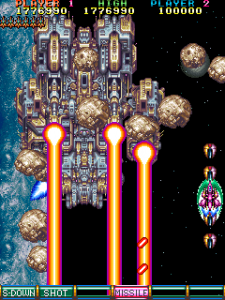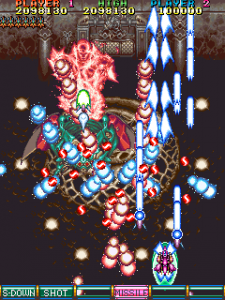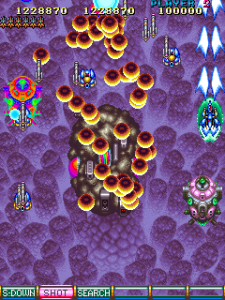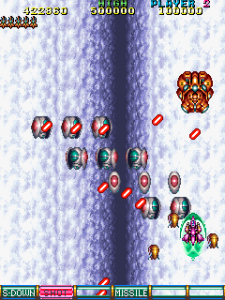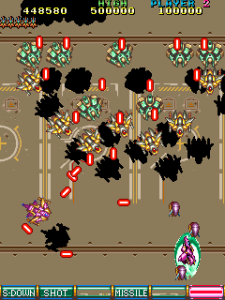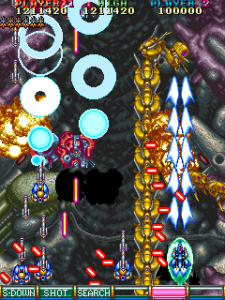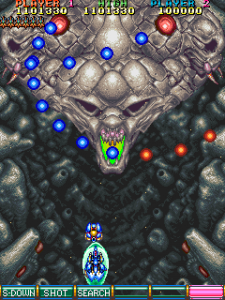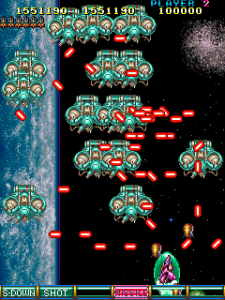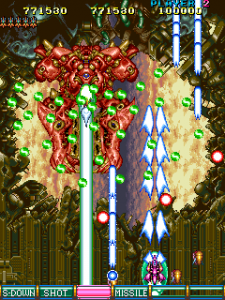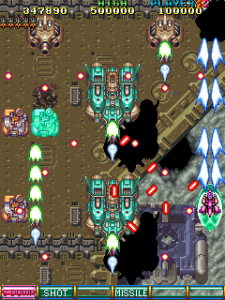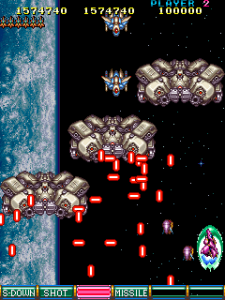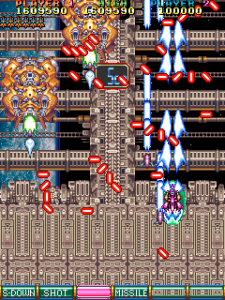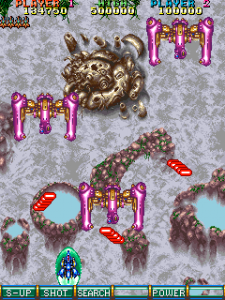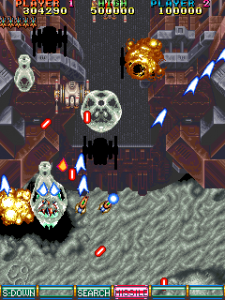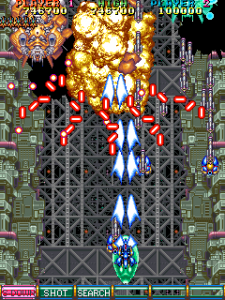V-Five, sometimes called V-V and also known as Grind Stormer, was one of Toaplan’s later games. It was programmed by Tsuneki Ikeda, who later went on to work on many similar games at Cave. The screen can be filled up with up to 80 bullets at once, especially on the later levels. There are five, long stages with lots of popcorn enemies and huge bosses at the middle and end of them. It’s also considered by many to be the spiritual successor to Slap Fight, as it uses similar elements and gameplay.
The story is very cheesy and is more than a little bit self-aware – it’s about about this horrifically hard video game that has been released in the year 2210. This game, also called V-Five, takes its victims and pulls them in, while making them hopelessly addicted like druggies in an opium deb. The government sends in an agent (the player, of course) to investigate this evil video game to save its victims by beating it. The arcade cabinet (or cartridge) supposedly contains this evil game from the future and you, the player, has supposedly been told by the government to beat this game. It tries to blur the line between fiction and reality a little, and it’s a fair bit better than the typical “save the galaxy!” story, but of course it’s really is just an excuse to blow stuff up.
V-Five has an upgrade bar similar to Slap Fight‘s, except your hitbox never increases in size. The power-ups include Speed Up, Shot, Search, Missile, Power, and Shield. Speed Up is pretty self-explanatory, except that it turns into speed down once it is fully powered up. Shot is the default form, with two to four Options that constantly follow you in a sort of V formation. By moving backward while not shooting, these options come close together and shoot a powerful laser, much like the one from Donpachi. By moving forward, your options spread out and shoot weaker attacks that can cover more of the screen. Search mode has your Options homing in on enemies and zipping through the screen from enemy to enemy. Missile has your Options following you, like in Gradius, and shooting destructive and powerful missiles. Mastering these three forms and knowing when to use them is key to survival in V-Five. The other two power-ups are Power and Shield. Power gives you more options and makes your attacks do more damage, while Shield gives you a force field that is surprisingly resilient. Unlike other Toaplan shooters, it does not feature a two-player simultaneous mode.
For the most part, V-Five is very much a typical Toaplan shooter. The levels are long, the bosses are intense, and the action is fast. Some of the best parts include a scene in level 2 where floating mountains start bouncing around the screen and colliding like asteroids. One of the bosses is a giant brain in a tube that can make earthquakes and use a purple bullet whip, and another is bizarre giant head enemy that can suck up its own attacks and spit them back out to make them stronger. The final boss deserves special mention for having an incredibly dense bullet pattern, and has this trick where his shots start suddenly acting strange and changing paths as though they have a mind of their own.
V-Five is known as Grind Stormer outside of Japan, which has some substantial mechanical differences. It completely removes the upgrade bar and replaces it with floating rectangles that have the power-up’s name on it, though they appear in roughly the same order as the upgrade bar. It also adds screen-clearing bombs, which can be used for more scoring opportunities. The removal of the upgrade bar makes the game feel a lot more restrictive, mostly because it’s harder to have the power you want when you need it. This mode (called “Bomber Ver.”) can also be played on the Japanese arcade version used a secret code.
V-Five is a really cool game, and if you look closely, like with many later Toaplan games, you can see smaller ideas that get refined and reused in later games by Cave, Raizing, and Takumi. It may not be the most well-known or well-polished game in Toaplan’s library, but it’s certainly worth looking into as long as you stay away from the watered down home version.
The Genesis/Mega Drive version was ported by Tengen, and includes both “V-Five” and “Grind Stormer” modes, so you basically get the original and arrange/overseas mode on the same cartridge. However, in spite of this nicety, this port isn’t all that great. Earlier Toaplan ports for the Genesis were fairly decent, but perhaps the arcade hardware was just too powerful for Sega’s aging 16-bit system to replicate, resulting in a game that looks muddy and sounds rather poor. The screen is pillarboxed to roughly maintain the original arcade ratio, but it’s still too short, and feels claustrophobic as a result. (To compensate for the extra difficulty, the shield is a little stronger.) It does have the benefit of having been released in North America, but due to production errors with some Tengen games, many carts no longer function without being repaired.
Screenshot Comparisons
